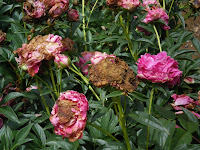Herbaceous peonies are rugged heirloom perennial plants valued for their drought tolerance and deer resistance. Breeders continue to introduce exciting hybrids to the marketplace featuring new color breaks, patterns and flower forms though carefully selected, nature will find any defect.
Hybrid herbaceous peonies flourish in mild springs. Flower durability and longevity translates into a long bloom season. Wet springs punctuated by persistent rainfall are a perfect environment for disease outbreaks. A chemical program begun in early spring as new shoots emerge mitigates future fungal problems.
 |
| Powdery Mildew |
Botrytis blight (Botrytis paeoniae), measles (Cladosporium paeoniae), and powdery mildew (Erisyphe polygoni) fungal spores can easily jump from plant to plant. Heavy winds or rains are great transportation modes for these nasty pathogens. Infection from neighborhood plantings or new garden center purchases is entirely possible. Rather than lamenting over misfortune or exacting blame, know the facts and respond with proper identification and treatment.
Botrytis is the most common peony disease. Symptoms appear in late spring on young leaf shoots about one foot in height. Susceptible center stems wilt and die. A brown or blackish rot appears at the base of leaves and stems. Affected areas of the stalk above ground will be covered by a gray mold filled with large spore populations. Immediate removal and treatment is essential to combat infection.
Peony Measles or “Red Spot” resemble small circular discolored lesions on leaves. Spots can combine to make foliate look irregularly blotched. The under surface of these areas becomes light brown. Different powdery mildew disease species can attack plants in the home and commercial landscape. Native dogwoods and hybrid lilac, honeysuckle, bee balm and zinnias are common hosts for these fungi. Herbaceous peonies have their own powdery mildew specialists that develop as a white film on leaves and stems. Infestation effects are seen in late summer. Protection applied during wet springs mitigates the disease’s devastating visual appearance.
Immunox® (Myclobutanil) is a reliable systemic fungicide labeled for botrytis and peony measles control. Spectracide® packages formulations in one quart containers for tank mixing. The Pest Management Guide from Virginia Cooperative Extension also suggests Ortho® Rosepride® (triforine) for powdery mildew control. Protective sprays should be made during favorable disease conditions as new foliage emerges and matures through spring. A spray for Measles is a good tool immediately following bloom season.
Good garden sanitation is a must. Spent flowers should be immediately removed during bloom season. Remove declining foliage each October. Collected debris should be tossed in the garbage or burned. NO COMPOSTING. Additional advice and information can be obtained from your local Cooperative Extension Office. Please follow product label for mixing and applying registered pesticides. Use a spreader sticker (surfactant) in your spray solution for best results.
 |
| Remove Old Blooms |

No comments:
Post a Comment